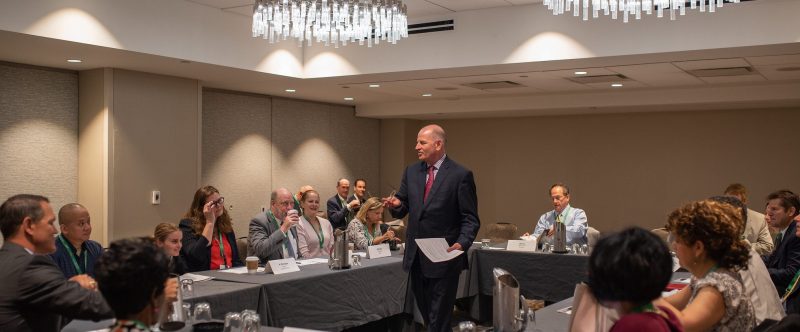Pick any local, state or federal government office in the United States, and employees are likely struggling with the shackles of legacy IT. Antiquated systems can stretch across technologies, from servers to applications to networks, and pain points differ office to office.
Insufficient systems elicit a cacophony of complaints from employees, who all believe that their technologies are the slowest, oldest and most inefficient. But as these voices are coming from every direction, leadership needs to find the highest impact and most valuable solutions to answer employees’ demands and allow for expansion down the road.
“It’s the same problems everyone else is having – old systems, old problems,” Michael McFarland, Director of Acquisition Business Systems for the Health and Human Services Department (HHS), said.
McFarland spoke at a GovLoop roundtable Wednesday morning that invited government employees to a discussion about IT modernization with leaders in acquisition and innovative solutions. The event, “Why Government Needs a Holistic Approach to IT Modernization,” heard from attendees and featured – alongside McFarland – speakers
- Jamie Baker, Senior Manager, Federal Civilian, Amazon Web Services (AWS),
- Steve Lefrancois, Public Sector Chief Technology Officer, Verizon and
- Bill Zielinski, Acting Assistant Commissioner, Office of Information Technology Category, General Services Administration (GSA).
Purchasing new solutions and contracts in government can take years. While it seems like spending money in the public sector should be as simple as it is in the private sector and in civilian life – where there’s a one-click purchase button – governments undergo intense security checks, systems integrations and lengthy schedules for implementation. A solution can turn from innovative to archaic throughout the course of a procurement process.
Under these conditions, government purchases must hit their targets and impact their mission immediately.
“I haven’t met an agency yet where their mission is building infrastructure,” Lefrancois said.
Simply updating a system because it’s old is not justification alone for leadership to invest large sums in a new, shiny product. However, improving the business process, saving costs and empowering employees are all far more compelling cases to upgrade IT, speakers said.
GSA’s mission is unique in that the agency exists to serve other agencies’ missions, Zielinski said. In managing a variety of contracts and schedules for agencies to use in federal procurement, GSA needs to be sure each case will prove necessary for the operation of federal agencies.
“We’re building a business case,” Zielinski said. “As we work with agencies to put in place large enterprisewide contracts to help their mission, we convert that to say ‘this is what the customer is looking for.’”
While employees search for the best way to modernize IT in government, some attendees said they preferred to start small and direct projects themselves. Fearing that a project could be caught up by IT departments resistant to change, attendees suggested that debuting a pilot project and expanding it could be the best way to incorporate modern solutions and revolutionize offices.
Blockchain, a system that immutably tracks inputs in a digital format, at HHS began as a pilot program, and after a successful trial, the distributed ledger program has been expanded throughout the department’s acquisition process. Achieving support in this way, however, requires executive support, McFarland said.
“Folks do want to start leveraging these new and emerging technologies,” Zielinski said, mentioning blockchain, robotic process automation and artificial intelligence as such technologies.
Technologies such as blockchain give agencies room to grow with their technology, with the incorporation of machine learning and automation – which blockchain can use to streamline acquisitions. To automate work, data is central.
Government workforces require mobile, clean and valuable data to build programs off of platforms and software. For this, cloud offers a secure and tailored format that offers many of these new technologies.
“It gives you that flexibility to try things, and not necessarily wait on a six- to nine-month procurement process,” Baker said.
As data needs to traverse multiple environments in order to make way for full-blown IT modernization, having it available remotely and in translatable formats is key. Online speed with cloud and fast-arriving 5G service will allow for data to be used like never before, as long as it’s kept in the right environment.
While there will never be a universal fix for lagging or lacking IT in government, focusing on data, business gains and people can help advance technologies for the future.
In case you missed the event, here are five themes to keep in mind.
- Security should be top of mind, but in federal governments and other systems, it’s no longer as much of a concern because of programs that vendors have to pass to be certified.
- Automation, blockchain, machine learning and artificial intelligence are changing the landscape of federal procurement, as these solutions can open up new opportunities. Furthermore, they can be incorporated into existing solutions.
- Business should be the primary responsibility. While IT considerations are important, try to work around whatever will make the most sense for the mission.
- Data is going everywhere to everyone, and it brings great opportunity. However, data also has to be clean and manageable for agencies.
- Users should be consulted when acquiring technologies, and agencies should engage them before a change occurs. People can contribute ideas, and proper preparation can alleviate pains of change management.






Bravo! Too many IT organizations have forgotten that their main goal should be serving their customers. Instead, many of them have come to believe that protecting IT assets and data are more important than learning how to leverage them to support business competitiveness and efficiency. Instead of getting a trusted IT advisor, you get a list of rules and phrases beginning with “we can’t do that.” Unfortunately, senior management may reinforce the belief in “protection over service” as they remember the unreliability of technology startups more than two decades ago. Those days are gone. Most software providers understand the need to provide reliable and secure solutions, as you have pointed out here. My favorite quote in the article:
“Users should be consulted when acquiring technologies, and agencies should engage them before a change occurs. People can contribute ideas, and proper preparation can alleviate pains of change management.”
Thanks, Rebecca. I think that’s definitely the idea, and a lot of folks feel the same way: that when it comes to systems, you just can’t win going through IT. You have to debut the project and then find a way to build it in after proving its business value.